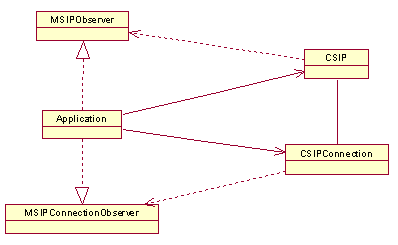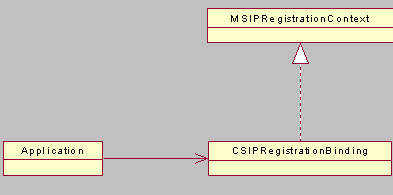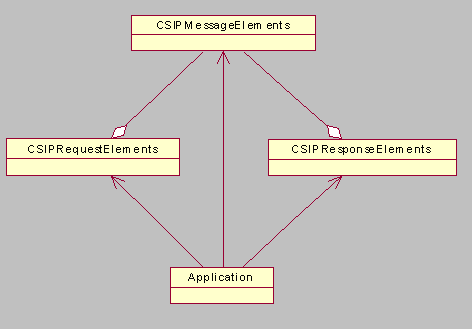Overview
The SIP Client API manages the multimedia sessions, subscribes to events, and sends SIP messages. It also provides access to the basic services of the SIP stack such as:
-
Sending and receiving of SIP messages
-
Creating registrations
-
Forming and tearing down dialogs initiated by INVITE, REFER and SUBSCRIBE requests
Architectural relationships
The SIP Client API uses the client-server mechanism to interact with the SIP stack. This means more than one client can use the SIP stack at the same time. The calls to the SIP Client API are synchronous. The SIP Client API implements a set of callback functions to pass the events back to the application.
Capability information
The following table describes the capabilities required to use the SIP Client API and the conditions in which they are required:
| Capability | Reason needed |
|---|---|
|
NetworkServices |
to send or receive SIP messages |
|
WriteDeviceData |
to create an instance of the CSIP class |
|
NetworkControl Location ReadDeviceData |
to use the function CSIPConnection::SetOptL() |
Extending the API
SIP Client API cannot be extended.
SIP Client API class structure
CSIP, MSIPObserver, CSIPConnection and MSIPConnectionObserver
An application creates a single instance of the CSIP class, and implements the callback functions defined by MSIPObserver . The CSIP uses the MSIPObserver functions. The CSIP class asks the supported security mechanisms and determines whether a CSIPConnection object exists for a given IAP.
The CSIP object creates an instance of CSIPConnection that allows you to send standalone SIP requests and ask for the state of the network connection. Responses are received through the MSIPConnectionObserver interface that defines a set of callback functions that an application must implement.
An application can have many CSIPConnection objects, but each of them must have a different IAP.
An existing CSIPConnection is required to create an instance of CSIPRegistrationBinding . The CSIPRegistrationBinding class provides services for registration, updating the registration, and deregistration. This class also provides instructions to the SIP stack to automatically refresh the registration, and to query and set the outbound proxy used by the registration.
CSIPDialogAssocBase is the base class for SIP dialog associations, such as CSIPInviteDialogAssoc , CSIPSubscribeDialogAssoc , CSIPReferDialogAssoc and CSIPNotifyDialogAssoc . The CSIPDialogAssocBase class is used to obtain the associated SIP dialog, for the associated CSIPDialog instance, and for sending a non-target Refresh request within the dialog.
Note: The SIP Client API creates the CSIPDialog instance, it cannot be created by the application.
If any of the CSIPInviteDialogAssoc , CSIPSubscribeDialogAssoc , CSIPReferDialogAssoc and CSIPNotifyDialogAssoc objects are associated, they are bound to an existing CSIPDialog object, or they can be used to create a new CSIPDialog object.
Note:
-
CSIPInviteDialogAssoc allows an application to initiate a dialog and to send INVITE ,, PRACK ,, ACK , UPDATE, and BYE requests related to the dialog.
-
CSIPSubscribeDialogAssoc allows an application to subscribe to different events by sending SUBSCRIBE and UNSUBSCRIBE requests. It also orders the SIP stack to automatically refresh the SUBSCRIBE request.
-
CSIPReferDialogAssoc allows an application to define and send REFER requests.
-
CSIPNotifyDialogAssoc allows an application to define and send NOTIFY requests.
Sent and received network requests
When a SIP request is sent to the network, the SIP Client API implementation creates a CSIPClientTransaction object and returns it to the application. A CSIPClientTransaction object represents the SIP transaction and consists of the SIP request and the SIP response. After receiving a response, the application gets CSIPResponseElements from the CSIPClientTransaction object. Note: Some client transactions can also be cancelled or refreshed.
When a SIP request is received from the network, it is passed to the application as a CSIPServerTransaction object. The application gets CSIPRequestElements from the CSIPServerTransaction object. A CSIPRequestElements object describes the kind of SIP request received. After the application determines the type of response to send, it uses the CSIPServerTransaction to send the responses.
CSIPTransactionBase is the base class for CSIPClientTransaction and CSIPServerTransaction . It provides the functions to obtain the current state of the transaction and the transaction type. Some operations are only allowed when the transaction is in a certain state. Note: The SIP Client API creates instances of CSIPClientTransaction and CSIPServerTransaction and they cannot be created by the application.
When a SIP request is sent to the network, the SIP Client API implementation creates a CSIPClientTransaction object and returns it to the application. A CSIPClientTransaction object represents the SIP transaction and consists of the SIP request and the SIP response. After receiving a response the application gets CSIPResponseElements from the CSIPClientTransaction object. Note: Some client transactions can be cancelled or refreshed.
When a SIP request is received from the network, it is passed to the application as a CSIPServerTransaction object. The application gets CSIPRequestElements from the CSIPServerTransaction object. A CSIPRequestElements object describes the type of SIP request received. After the application determines the type of response to send, it uses the CSIPServerTransaction to send the responses.
CSIPTransactionBase is the base class for CSIPClientTransaction and CSIPServerTransaction . It provides functions to obtain the current state of the transaction and the transaction type. Some operations are only allowed when the transaction is in a certain state. Note: The SIP Client API creates instances of CSIPClientTransaction and CSIPServerTransaction and they cannot be created by the application.
Automatically refreshing a SIP request
The SIP stack automatically refreshes a SIP request using the CSIPRefresh object. REGISTER , SUBSCRIBE and a request outside the dialog are refreshed. After sending a refresh request, the application queries the state of the refresh from CSIPRefresh .
CSIPRefresh provides functions for updating and terminating the refresh, for requests outside the dialog. The CSIPRegistrationBinding and CSIPSubscribeDialogAssoc classes are used to update and terminate a refreshed REGISTER or SUBSCRIBE .
Managing HTTP digest security settings
An application must create an instance of the CSIP class to use CSIPHttpDigest . The CSIPHttpDigest class manages HTTP digest security settings and contains only static functions.
Memory used
After the CSIP and CSIPConnection objects are created, most of the memory consumed is by CSIPMessageElements , CSIPRequestElements and CSIPResponseElements classes. CSIPTransactionBase holds the most recent SIP response in a CSIPResponseElements object. When another response is received, the previous CSIPResponseElements object is deleted and a new one is created.
CSIPClientTransaction contains a CSIPRequestElements object until the SIP request is transferred to the server side of the SIP stack. CSIPServerTransaction contains the SIP request as CSIPRequestElements . The application owns the CSIPClientTransaction and CSIPServerTransaction objects. When the transaction terminates, the application deletes these objects to conserve memory.
A non- INVITE CSIPClientTransaction is deleted when it has received a final response or when the ErrorOccured() callback is called. A non- INVITE CSIPServerTransaction is deleted after the application sends a final response.
The INVITE related transactions are deleted if the ErrorOccured() callback function is called. These transactions behave differently because of the presence of an ACK .
When the application sends a 2xx response to an INVITE related CSIPServerTransaction , it enters the CSIPTransactionBase::ETerminated state and it is deleted at this point. A new CSIPServerTransaction object receives the ACK.
When the application sends an INVITE request and the CSIPClientTransaction receives a 2xx response, the transaction enters the CSIPTransactionBase::ETerminated state. The associated CSIPClientTransaction must not be deleted as it is required to send the ACK and also to receive the MSIPConnectionObserver::InviteCompleted() callback. An INVITE related CSIPClientTransaction must be deleted only after a MSIPConnectionObserver::InviteCompleted or MSIPConnectionObserver ::ErrorOccured event is received, or if the state of the associated CSIPConnection goes to CSIPConnection::EInactive or CSIPConnection::EUnavailable .
Copyright ©2010 Nokia Corporation and/or its subsidiary(-ies).
All rights
reserved. Unless otherwise stated, these materials are provided under the terms of the Eclipse Public License
v1.0.






